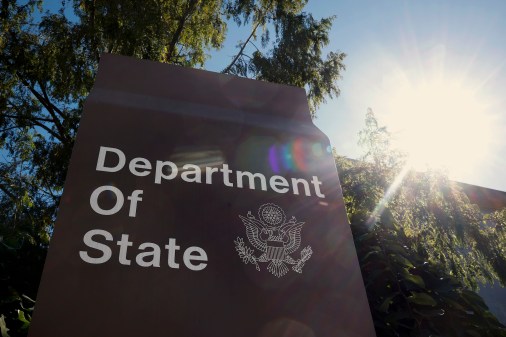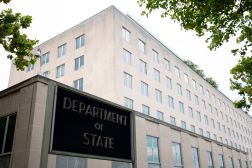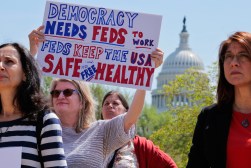Feds prep for possible shutdown
The Office of Management and Budget reached out to agencies this week to begin preparing for a possible government shutdown Oct. 1.
Following a plan it released earlier this year, OMB convened a conference call to discuss orderly shutdown plans with agency senior officials Monday — ahead of the looming Sept. 30 deadline for Congress to pass a continuing funding resolution.
Though administration officials believe a budget lapse shouldn’t occur, and hope it can be avoided, “prudent management requires that the government plan for the possibility of a lapse and OMB is working with agencies to take appropriate action,” an OMB spokeswoman said in a statement.
“This includes agencies reviewing relevant legal requirements and updating their plans for executing an orderly shutdown,” she said. “Determinations about specific programs are being actively reviewed as agencies undertake this process.”
In 2013, the budget lapse snuck up on many federal agencies, which hadn’t experienced a shutdown since 1995, when the government was still a very paper-based enterprise. But this time around, just two years removed from the prior lapse and with operating plans still fresh, agencies are more prepared. OMB, as part of its update to Circular A-11, also required that agencies submit updated shutdown plans by Aug. 1 and continue to do so every two years.
It’s in these shutdown plans that agencies describe which personnel are considered essential — and must operate normally through the appropriations lapse without pay — and which are nonessential, meaning after a half day of closing procedures they will be sent home indefinitely without pay until the shutdown is resolved. These plans vary by agency depending on importance of mission and appropriation types for different programs. For instance, programs related to national security and public safety will continue on if a shutdown occurs, whereas the national parks around the country will be closed.
“There hadn’t been a shutdown since 1995-1996 before 2013,” John Cooney, a partner with law firm Venable LLP and former counsel for OMB’s Office of Information and Regulatory Affairs in the 1980s, said Monday at an event sponsored by the Professional Services Council. “And everything had changed within the agencies because of the introduction of computerized databases, more work being contracted out, computerized communications systems … agencies had to rethink many things.”
“Since the experience is only two years behind them now, I think the agencies make the rational assumption that what happens this time around will more or less be the same as 2013,” Cooney added. “The government learned a lot of lessons from what happened in 2013.”
The Defense Department is in that boat. DOD Press Secretary Peter Cook said Tuesday that the department is undergoing “prudent planning” but holding out hope that it won’t have to endure the same impacts it did two years ago.
“As you can imagine we have, unfortunately, gone through this before. We are conducting the prudent planning that would be needed in the invent something like that happens, we do have some experience at that,” Cook said.
He added, “We’re not at that stage right now that we need to be alarming or concerning employees with it. We still believe that there’s time to reach a resolution, but we have to do prudent planning, and the comptroller has been doing that. Others within this department taking those steps necessary in the event, not only that we potentially see a budget shut-down, but also even a continuing resolution.”
What will happen when the clock strikes midnight Oct. 1 is still up in the air. Despite its preparations, OMB hopes “that this work will ultimately be unnecessary and that there will be no lapse in appropriations,” the spokeswoman said.
“There is enough time for Congress to prevent a lapse in appropriations, and the Administration is willing to accept a clean, short-term continuing resolution to fund Government operations and allow Congress more time to negotiate an agreement that invests in middle-class economic priorities and helps our entire economy grow,” she said.
Others are not so confident that the gridlock will get worked out in time.
PSC’s last-minute meeting Monday was well attended by members of the contracting community worried they’ll be refused entry to their job sites and defunded Oct. 1. And several of the speakers gave their best predictions of what will occur, ranging from a short shutdown effective Oct. 1 to a longer shutdown extending off and on with stopgap funding bringing the government in and out of closure.
California Rep. Darrell Issa, part of the House Republican contingent blamed for this shutdown saga, wouldn’t say if he thought the shutdown would happen, but he did say he’d do everything he could to vote to keep government running.
“I will vote to keep the government open,” Issa told FedScoop. “I will not leave here during a government shutdown. I will vote for something every day if I get a chance that will keep the government open and operating,” displacing the blame on to the president and Senate.
But, in a new column on his Forbes blog, Stan Collender, executive vice president at Washington, D.C.-based Qorvis MSLGROUP and former congressional budget staffer, puts the probability of a shutdown at 75 percent.
“So, with less than 10 calendar days left before the fiscal year begins, congressional Republicans still have to negotiate with each other before they even begin to negotiate with House and Senate Democrats and the White House … and there’s no obvious (or perhaps possible) resolution in sight,” Collender wrote. “That makes my 75 percent estimate of a shutdown seem optimistic.”
Greg Otto contributed to this story.






